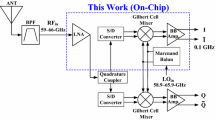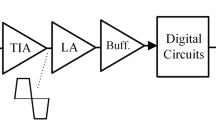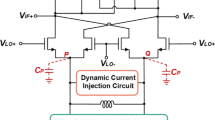Abstract
A 7-channel imaging diversity receiver based on current-summing is implemented in a 180 nm CMOS technology for broadband free-space optical (FSO) multi-input/multi-output (MIMO) communication. Each channel employs a low input-impedance current mirror (CM) as the input stage, which allows the implementation of direct current-summing for equal-gain combining (EGC). The summed current signal drives a second stage transimpedance amplifier (TIA) to generate the output voltage. Electrical characterization was performed using a photodiode emulation circuit and chip-on-board FR-4 assembly, demonstrating a total transimpedance gain of 62 dBΩ, −3 dB bandwidth of 1.2 GHz, and eye diagrams up to 2 Gb/s for 0.25 pF photodiode capacitance. The theoretical sensitivity of the imaging receiver is −16.8 dBm for a bit error rate (BER) of 10−9 at a photodetector responsivity of 0.4 A/W. The simulated power consumption for a single front-end amplifier circuit is 4.2 mW, and for the second stage TIA is 10.3 mW from a single 1.8 V supply. The diversity receiver is flip-chip compatible to enable hybrid integration to a custom InGaAs photodetector array.





















Similar content being viewed by others
References
Jivkova, S., & Kavehrad, M. (2003). Shadowing and blockage in indoor optical wireless communications. Proceedings of IEEE GLOBECOM, Dec. 2003, Vol. 6, pp. 3269–3273.
Alqudah, Y., Kavehrad, M., & Jivkova, S. (2004). Optical wireless multispot diffusing: A MIMO configuration. Proceedings of IEEE international conference on communications, June 2004, Vol. 6, pp. 3348–3352.
Hranilovic, S., & Kschischang, F. (2006). A pixelated MIMO wireless optical communication system. IEEE Journal of Selected Topics in Quantum Electronics, 12(4), 859–874.
Jivkova, S., Hristov, B. A., & Kavehrad, M. (2004). Power-efficient multispot-diffuse multiple-input-multiple-output approach to broad-band optical wireless communications. IEEE Transactions on Vehicular Technology, 53(3), 882–889.
Al-Ghamdi, A., & Elmirghani, J. (2004). Analysis of diffuse optical wireless channels employing spot-diffusing techniques, diversity receivers, and combining schemes. IEEE Transactions on Communications, 52(10), 1622–1631.
Hajjarian, Z., & Kavehrad, M. (2009). Using MIMO transmissions in free-space optical communications in presence of clouds and turbulence. Proceedings of the SPIE, Vol. 7199, pp. 71 990V–71 990V-12,
Djahani, P., & Kahn, J. (2000). Analysis of infrared wireless links employing multibeam transmitters and imaging diversity receivers. IEEE Transactions on Communications, 48(12), 2077–2088.
Tang, A. P., Kahn, J. M., & Ho, K. P. (1996). Wireless infrared communication links using multi-beam transmitters and imaging receivers. Proceeding of IEEE international conference on communications, June 23–27, 1996, pp. 180–186.
Jungnickel, V., Frock, A., Haustein, T., Kruger, U., Pohl, V., & von Helmolt, C. (2003). Electronic tracking for wireless infrared communications. IEEE Transactions on Wireless Communications, 2(5), 989–999.
Tavares, A., Valadas, R., Aguiar, R. L., & Duarte, A. O. (2003). Experimental characterization of rate adaptive transmission and angle diversity reception techniques. IEEE Wireless Communications, 10(2), 36–44.
Parand, F., Faulkner, G. E., & O’Brien, D. C. (2003). Cellular tracked optical wireless demonstration link. IEE Proceedings on Optoelectronics, 150(5), 490–496.
Joyner, V. M., Holburn, D. M., O’Brien, D. C., & Faulkner, G. E. (2006). A CMOS imaging diversity receiver chip with a flip-chip integrated detector array for optical wireless links. Proceedings of IEEE LEOS Annual Meeting, Oct. 2006, Vol. 1–2, pp. 927–928.
Acknowledgment
This work was supported by the National Science Foundation under Grant No. ECCS-0823946.
Author information
Authors and Affiliations
Corresponding author
Rights and permissions
About this article
Cite this article
Joyner, V.M., Zeng, J. A CMOS imaging diversity receiver for gigabit free-space optical MIMO. Analog Integr Circ Sig Process 66, 371–379 (2011). https://doi.org/10.1007/s10470-010-9535-z
Received:
Revised:
Accepted:
Published:
Issue Date:
DOI: https://doi.org/10.1007/s10470-010-9535-z




